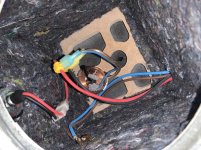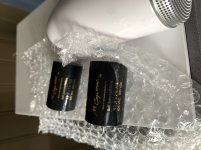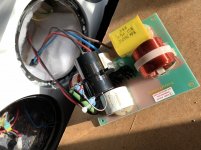I second Art's opinion.
That's a quite radical move going from first order to third order solely in the twitter section.
I had an experience with a complete rework of my B&W 685 crossover (1st order) to a third order because I was bugged with part of the midrange sounding forward and there was some graininess probably coming from the twitter.
Despite using top notch components, with measurement wise obviously better response, stronger bass too due to using thicker wire for the coils, it ended up killing the life out of those speakers.
It's many variables involved and in such a top model, physical placements of the drivers must have been taken in the equation. The original crossover is quite elaborate, I doubt B&W were cutting corners in this model.
I'd go with the milder mod without changing the order of the crossover.
That's a quite radical move going from first order to third order solely in the twitter section.
I had an experience with a complete rework of my B&W 685 crossover (1st order) to a third order because I was bugged with part of the midrange sounding forward and there was some graininess probably coming from the twitter.
Despite using top notch components, with measurement wise obviously better response, stronger bass too due to using thicker wire for the coils, it ended up killing the life out of those speakers.
It's many variables involved and in such a top model, physical placements of the drivers must have been taken in the equation. The original crossover is quite elaborate, I doubt B&W were cutting corners in this model.
I'd go with the milder mod without changing the order of the crossover.
Before making significant alterations to the crossover - such as the proposed mod to 3rd order filter I would simply add a 0.5R resistor in series with the tweeter plus also add a 0.68mH in parallel with the tweeter.
This will reduce the tweeter level by about 1dB and reduce the 2kHz dip by 1-2dB.
Changing to a third order, without moving the tweeter for phase alignment will likely alter the vertical lobe significantly in the crossover region.
Thanks Art!
Good advice - and also a simple mod to try before potentially advancing to the 3rd order scheme.
Are your proposed values for the resistor and inductor based on experience or did you do any simulations/ calculations? I have ordered a selection of coils and resistors and to be able to experiment, but I do like an scientific approach 🙂
Regards,
Bjarne
Hi sharbatgula!
Thanks for you response and advice.
I will start with Art's suggestion and evaluate how that works.
Interesting to read about your experience with 685 and the missing dynamics. I hope not to copy that result 🙂
Regards,
Bjarne
Thanks for you response and advice.
I will start with Art's suggestion and evaluate how that works.
Interesting to read about your experience with 685 and the missing dynamics. I hope not to copy that result 🙂
Regards,
Bjarne
I second Art's opinion.
That's a quite radical move going from first order to third order solely in the twitter section.
I had an experience with a complete rework of my B&W 685 crossover (1st order) to a third order because I was bugged with part of the midrange sounding forward and there was some graininess probably coming from the twitter.
Despite using top notch components, with measurement wise obviously better response, stronger bass too due to using thicker wire for the coils, it ended up killing the life out of those speakers.
It's many variables involved and in such a top model, physical placements of the drivers must have been taken in the equation. The original crossover is quite elaborate, I doubt B&W were cutting corners in this model.
I'd go with the milder mod without changing the order of the crossover.
I second Art's opinion.
That's a quite radical move going from first order to third order solely in the twitter section.
I had an experience with a complete rework of my B&W 685 crossover (1st order) to a third order because I was bugged with part of the midrange sounding forward and there was some graininess probably coming from the twitter.
Despite using top notch components, with measurement wise obviously better response, stronger bass too due to using thicker wire for the coils, it ended up killing the life out of those speakers.
It's many variables involved and in such a top model, physical placements of the drivers must have been taken in the equation. The original crossover is quite elaborate, I doubt B&W were cutting corners in this model.
I'd go with the milder mod without changing the order of the crossover.
Well, Art's suggestion makes the tweeter network second order.
One of the problems with the original design is that the midrange phase response is roughly third order and the tweeter response is roughly first order. The result is a wide frequency overlap between the drivers within which the phase match is all over the place. Consequently the crossover lobe swings vertically through about 25 degrees over that range and the frequency response varies wildly with vertical off-axis angle. This creates the W-shaped on-axis response that seems to be standard for B&W 3-way systems now. You can see this in the "before" plots in post #339.
I don't get it. B&W crossover design used to be more conventional. Now someone there must think that this approach is somehow better than what pretty much everyone else is doing.
Sound-wise, my experience is the opposite of yours. I modified one speaker so I could compare "before" and "after", and "after" fixed most of the things that were bothering me, so I immediately modified the second one. Maybe we are looking for different things.
Thanks Art!
Good advice - and also a simple mod to try before potentially advancing to the 3rd order scheme.
Are your proposed values for the resistor and inductor based on experience or did you do any simulations/ calculations? I have ordered a selection of coils and resistors and to be able to experiment, but I do like an scientific approach 🙂
Regards,
Bjarne
Hi Bjarne,
Yes, based on simulation, and if you read back through this thread you'll see that I've similarly modified the crossovers in my 800 Diamonds.
The dip at 2-2.5kHz is mostly a consequence of the FST and tweeter being out of phase, and there's still reasonable output from the tweeter at that frequency due to the first order filter. The primary reason for the phase error is that the tweeter has been physically moved (forward) by a half wavelength (at 4kHz) rather than 'phase inverted' - as per convention. The FST and tweeter are in-phase at the crossover frequency (4kHz) but out of phase at approx 6kHz and 2kHz. The phase error at 6kHz is of less consequence because the FST is very directional at that frequency, so is easily eliminated by listening slightly off-axis, but the error at 2kHz is of more consequence because the tweeter's beamwidth is very broad, and the dip also reflects a dip in the power response at this frequency.
So why this approach by B&W?
My guess is that they felt that the 'BBC dip' was more desirable for classical music reproduction.
Incidentally, rumors abound that B&W will be releasing a D4 version of the 800 series in June this year, so it will be interesting to see what's changed and whether they've revised their approach to crossover design.
Cheers,
Art.
Before making significant alterations to the crossover - such as the proposed mod to 3rd order filter I would simply add a 0.5R resistor in series with the tweeter plus also add a 0.68mH in parallel with the tweeter.
This will reduce the tweeter level by about 1dB and reduce the 2kHz dip by 1-2dB.
Changing to a third order, without moving the tweeter for phase alignment will likely alter the vertical lobe significantly in the crossover region.
Hi Art
Where should the resistor and parallel coil be connected with respect to the existing capacitor? The most convenient for me would be to install the resistor after the cap and to connect the coil either forward or after the resistor. But i guess it makes a differerence and should be wired according to your simulation assumptions for the correct result 🙂
Regards, Bjarne
Hi Art
Where should the resistor and parallel coil be connected with respect to the existing capacitor? The most convenient for me would be to install the resistor after the cap and to connect the coil either forward or after the resistor. But i guess it makes a differerence and should be wired according to your simulation assumptions for the correct result 🙂
Regards, Bjarne
Hi Bjarne,
Resistor must be before the cap (input) and inductor to ground after the cap (output).
Cheers,
Art
Mod ongoing. One of these rare occations when I wish my hands and fingers were the size of a female pornstars.
Ok, soldering next.
Ok, soldering next.
Attachments
-
 E6EFC4E5-7DFE-420A-A64E-611838033DA4.jpeg88.7 KB · Views: 103
E6EFC4E5-7DFE-420A-A64E-611838033DA4.jpeg88.7 KB · Views: 103 -
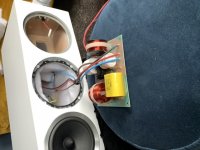 3DDADC00-839A-4EFA-A50E-3E80FC464E5A.jpeg102.1 KB · Views: 99
3DDADC00-839A-4EFA-A50E-3E80FC464E5A.jpeg102.1 KB · Views: 99 -
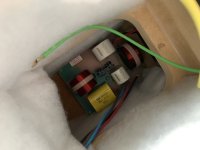 27770759-6349-42BB-9477-5D9F92E88726.jpeg58.1 KB · Views: 96
27770759-6349-42BB-9477-5D9F92E88726.jpeg58.1 KB · Views: 96 -
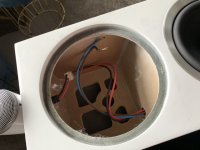 B052C779-4AAD-4E6C-ABCA-B010526DDEDA.jpeg80.5 KB · Views: 100
B052C779-4AAD-4E6C-ABCA-B010526DDEDA.jpeg80.5 KB · Views: 100 -
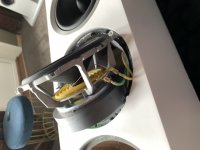 18D2B748-3042-4034-881B-9C8B793115D8.jpeg71 KB · Views: 102
18D2B748-3042-4034-881B-9C8B793115D8.jpeg71 KB · Views: 102
My plan was to line the mid chamber with felt, but I cannot access the inner half due to bracing. Kind of surprised of the build quality, the bottom side is actually «shelfed» with an inclining angle, my guess to avoid parallel walls.
Up and running with Art’s proposal. Tried some different coils and settled for 0,8 mH for now. The resistor ended up at 0.6ohm (1+1.2 Ohm in parallel, close enough).
Also the midrange front chamber is now lined with 8mm felt.
First impressions after 1 hour of listening:
- more balanced sound, i.e. more bass vs highs.
- phase seems to be improved. Q-sound effects much more clear: Roger Waters dog is barking waaay outside the house instead of inside the speakers
- i can listen to metal again, yeah!! This is the biggest plus 🙂
Now for some more listening. I will live with this for a while before potentially going for 3.order approach.
B
Also the midrange front chamber is now lined with 8mm felt.
First impressions after 1 hour of listening:
- more balanced sound, i.e. more bass vs highs.
- phase seems to be improved. Q-sound effects much more clear: Roger Waters dog is barking waaay outside the house instead of inside the speakers
- i can listen to metal again, yeah!! This is the biggest plus 🙂
Now for some more listening. I will live with this for a while before potentially going for 3.order approach.
B
Finally the coils arrived. I ordered two pair of 0.68mH, one with 0.5 Ohm dcr and one with 1.0 Ohm dcr.
Higher dc resistance should reduce crossover slope and would also impact phase.
So another question for Art: which coil will in theory be best in this case?
While waiting for answers I will install the 1.0 Ohm coils 🙂
Higher dc resistance should reduce crossover slope and would also impact phase.
So another question for Art: which coil will in theory be best in this case?
While waiting for answers I will install the 1.0 Ohm coils 🙂
Thanks Art
Have listened some hours now with 0.68mH. First impression tells me that I preferred 0.8mH.
Are the sims very different for these to inductance values?
Have listened some hours now with 0.68mH. First impression tells me that I preferred 0.8mH.
Are the sims very different for these to inductance values?
0.68mH worked best for me, but go with what sounds best in the range 0.56mH - 1.0mH. Lower values best eliminate the dip at 2kHz but at the cost of boosting the mid treble slightly. I ended up dropping the series tweeter cap from 4.7uF to 4.4uF.
Well, Art's suggestion makes the tweeter network second order.
One of the problems with the original design is that the midrange phase response is roughly third order and the tweeter response is roughly first order. The result is a wide frequency overlap between the drivers within which the phase match is all over the place. Consequently the crossover lobe swings vertically through about 25 degrees over that range and the frequency response varies wildly with vertical off-axis angle. This creates the W-shaped on-axis response that seems to be standard for B&W 3-way systems now. You can see this in the "before" plots in post #339.
I don't get it. B&W crossover design used to be more conventional. Now someone there must think that this approach is somehow better than what pretty much everyone else is doing.
Sound-wise, my experience is the opposite of yours. I modified one speaker so I could compare "before" and "after", and "after" fixed most of the things that were bothering me, so I immediately modified the second one. Maybe we are looking for different things.
I'm glad your mod came out good. I had so much hopes on mine, but instead of sonic heaven, I learned a lesson that improved frequency (and phase) response doesn't solely represent the overall sound of the speaker. For some reason, mine lost the overall liveliness and went the opposite way of forward, vocals didn't pop in and sounded subdued. That made me reconsider my position regarding B&W crossover designs that it's not tending towards simpler only to cut costs/increase revenue margin, but that indeed, there is something beneficial behind a simple crossover, despite the shortcomings that were clearly bugging me. I know a few people who love them and do not notice anything wrong in their sound signature.
- Home
- Loudspeakers
- Multi-Way
- B&W Signature 800 upgrade diamond tweeter
